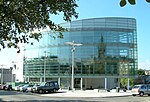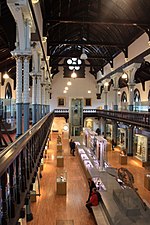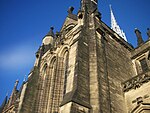The University of Glasgow (abbreviated as Glas. in post-nominals; Scottish Gaelic: Oilthigh Ghlaschu) is a public research university in Glasgow, Scotland. Founded by papal bull in 1451 [O.S. 1450], it is the fourth-oldest university in the English-speaking world and one of Scotland's four ancient universities. Along with the universities of Edinburgh, Aberdeen, and St Andrews, the university was part of the Scottish Enlightenment during the 18th century.
In common with universities of the pre-modern era, Glasgow originally educated students primarily from wealthy backgrounds; however, it became a pioneer in British higher education in the 19th century by also providing for the needs of students from the growing urban and commercial middle class. Glasgow University served all of these students by preparing them for professions: law, medicine, civil service, teaching, and the church. It also trained smaller but growing numbers for careers in science and engineering. The annual income of the institution for 2021–22 was £923.6 million of which £196.1 million was from research grants and contracts, with an expenditure of £998.5 million. The university has the sixth-largest endowment of any university in the UK. It is a member of Universitas 21, the Russell Group and the Guild of European Research-Intensive Universities.
The university was originally located in the city's High Street; since 1870, its main campus has been at Gilmorehill in the City's West End. Additionally, a number of university buildings are located elsewhere, such as the Veterinary School in Bearsden, and the Crichton Campus in Dumfries.Glasgow is the largest university in Scotland by total enrolment and with over 19,500 postgraduates the second-largest in the United Kingdom by postgraduate enrolment. The university places within the world's Top 100 universities. More specifically, it ranked 81st and 82nd globally in the 2023 QS World University Ranking and 2023 Times Higher Education World University Rankings respectively, as well as placing top 15 nationally in domestic rankings. According to the Research Excellence Framework (REF) 2021, Glasgow was ranked joint 13th in the UK for the quality of its research (GPA), an improvement of 11 positions from the previous exercise. The university was awarded the "2020 THE University of the Year" in recognition of its contribution to reparative justice.The alumni of the University of Glasgow include some of the major figures of modern history, including James Wilson, a signatory of the United States Declaration of Independence, 3 Prime Ministers of the United Kingdom (William Lamb, Henry Campbell-Bannerman and Bonar Law), 2 Scottish First Ministers (Nicola Sturgeon and Donald Dewar), economist Adam Smith, philosopher Francis Hutcheson, engineer James Watt, physicist Lord Kelvin, surgeon Joseph Lister along with 8 Nobel Prize laureates and numerous Olympic gold medallists, including the current chancellor, Dame Katherine Granger.







